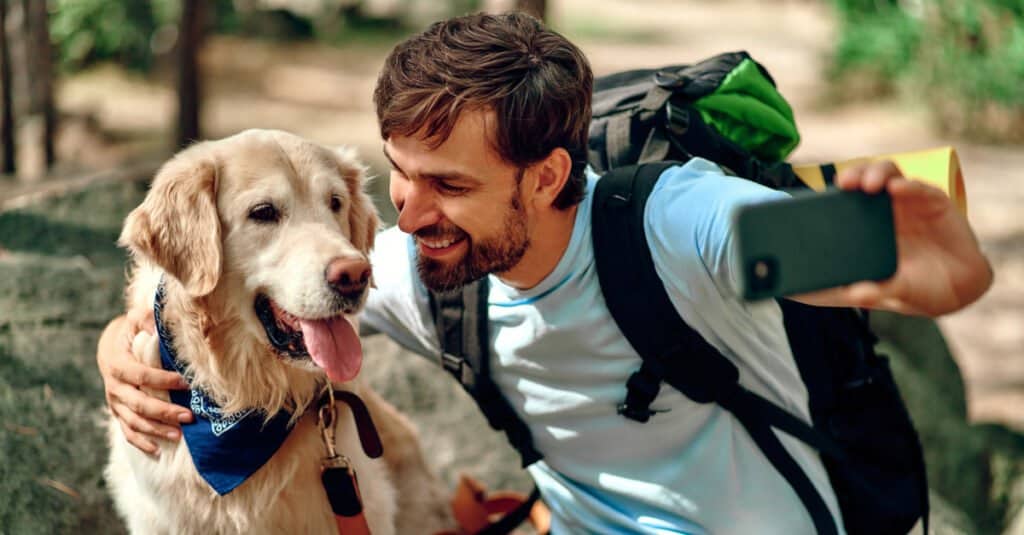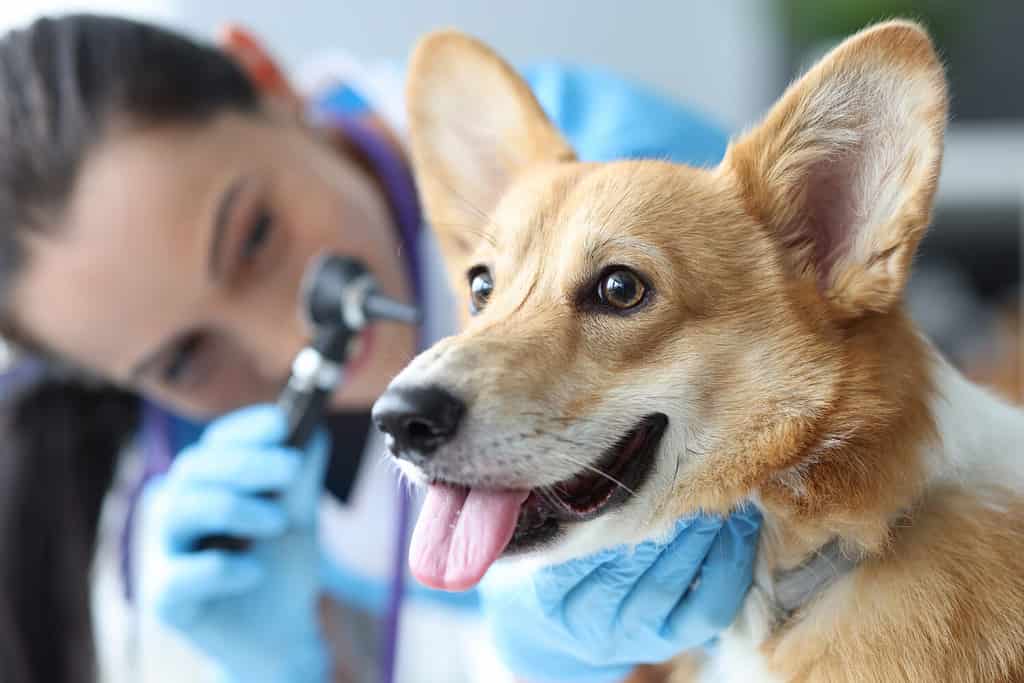Spending time in nature is great for your mind, body, soul, and dog. Although enjoying free time hiking with their dog may not be a new idea to some, many people discovered a new-found passion for the outdoors because of the COVID-19 mandatory shutdowns a few short years ago. If you’re new to the hiking scene and want to start bringing man’s best friend with you, keep reading for 10 critical lessons to know before hitting the trail with your pup!
1. Hiking 101: Preparing Your Dog for the Trails

Hiking is a great pastime for both people and our furry companions.
©Larry Barrett/Shutterstock.com
Before introducing your pooch to hiking, it’s important to consider a few items for Fido’s safety. How old is your dog? What is his or her current fitness level? Have they had a regular check-up at the vet lately, and are they in good health? Once your beloved furry friend has received the OK from the veterinarian, it’s important to plan your hiking distances and difficulty level based on how much regular exercise they get. If you and your best friend are new to spending time outdoors, start with easier, shorter trails and work your way up to longer, more difficult ones.
Please note: while it can be exciting to bring a new puppy out on the trails, it can take anywhere from 6 to 18 months for a pup’s growth plates to close, depending on the size of the dog. Discuss the exercise limitations of your newest furry family member before bringing a pup hiking. Also, consider bringing a backpack that you can occasionally carry your puppy in as a great and safe compromise for spending time together outdoors!
2. Fueling Fido for the Hiking Trails

Dogs require additional hydration and food while hiking and backpacking.
©iStock.com/Vadim Gavrilov
If your furry friend is healthy and ready to start exploring, your first hiking necessity will be determining how to best fuel your dog while on the trail. Keep the following items readily available, depending on your upcoming trips.
Packable Dog Dishes
Ensure you have size-appropriate, lightweight dog bowls that you can use to give your dog fresh water on every hike. Have a second bowl available to feed them if you’re planning a longer day hike or an overnight backpacking trip. I recommend the silicone collapsible dog bowls you can easily flatten and attach to the outside of your pack with a carabineer.
Your Dog’s Hydration
When hiking with your dog, it’s important to remember that both of you need to stay fully hydrated. While it may be easier to let your pooch sneak a quick sip from puddles and streams, several water-borne illnesses can impact your pup’s health. Take into consideration how much exercise your dog will be getting and how hot it is outside when planning to carry fresh water with you, and make sure you have proper supplies for water filtration if you’ll be backpacking for several days. Click here to learn more about dehydration in dogs.
Trail Treats
Bringing Fido’s favorite treats on the trail is crucial to hiking success. Whether you’ll be practicing basic obedience and recalls or trying to keep their attention for the perfect vista photo, carrying a bag of your pup’s snacks is non-negotiable. Just like for you, trail treats also help ensure your dog’s daily calorie intake is supporting the amount of exercise they’re getting from their hiking trip.
Full Meals for Longer Hikes
When backpacking or hiking longer, more challenging trails, you’ll also need to plan out your dog’s meals. If your dog’s standard meals aren’t ideal to carry on trail and you want to try alternative options, such as freeze-dried dog foods, make sure you transition them to the new food before your hike. You don’t want to gamble with gastrointestinal distress or simply your dog not liking the new food while they’re being extremely active and in need of the calories. Additionally, packing the average amount of your dog’s day-to-day food likely isn’t enough due to the increase in physical activity. Depending on the length and difficulty of your trip, you could need to increase your dog’s portions anywhere up to 50- or 100 percent. To ensure sufficient nutrition, discuss your trip and your dog’s needs with your veterinarian before leaving.
3. Plan Your Dog’s Hiking Gear

Make sure your dog has appropriate hiking gear to keep their tail wagging on the trail.
©Javier Brosch/Shutterstock.com
You’ve broken in your comfortable and reliable hiking boots and pack, but what about your dog? While your furry friend may not need trek poles to traverse creeks and teetering rocks, there’s still plenty of hiking gear to keep your pup’s tail wagging on the trail.
Paw Protection
Depending on the terrain you’ll encounter on the trail, it’s important to plan to protect your pup’s precious paws. For extremely hot and rocky trips, invest in sturdy dog boots that don’t interfere with your dog’s natural gait while walking. Additionally, paw balms are compact and easy to carry to help massage tired paws after a long day, as well as to protect them from extremely cold conditions.
Eye Protection
Are you planning to frequent arid desert trails that expose you to the sun often? Or, do you have a dog with excellent recall who likes to excitedly burst through bushes like the Kool-Aid Man? Pro tip: a pair of Rex Specs doggy goggles is less expensive than eye surgery. These doggles protect your dog from not only UVA and UVB rays but also any sticks and branches they may barrel through along the way.
Sunscreen
In addition to eye protection, if you and your dog will likely be exposed to a high amount of direct sunlight, pay close attention to any patches of thin or white fur that could be susceptible to sunburn. Areas such as the muzzle, paws, and ears can be especially sensitive for some dogs and may need the occasional application of sunscreen throughout your hike.
Leashes
While some trails may permit off-leash dogs, it’s always important to at least carry a leash on you. Leashing your dog allows you to keep your pup out of sketchy waters, prevents them from eating undesirable plants (or worse), and minimizes the risk of running up to unfriendly wildlife on the trail. Furthermore, it’s common courtesy to keep dogs without reliable recalls on leashes to prevent them from excitably charging up to fellow hikers or other unexpectant trail dogs who may not be interested in making new friends.
Durable and easy-to-clean biothane leashes are a perfect option to withstand the rigors of the great outdoors and come in a large variety of colors and lengths. When traveling a less populated trail, my occasionally overly social wiggle-butt enjoys the freedom of a 10-foot leash, which allows her some room to roam while I still have complete control over her whereabouts.
Poop Bags
Leave No Trace doesn’t only apply to you. Just like human waste, dog poop should either be packed out or buried in a cathole that is 4-6 inches wide and 6-8 inches deep. Many pet companies, Ruffwear and Kong, for example, offer scent-resistant pouches and other solutions for packing out your pup’s waste. Some hikers have used more creative options, such as an empty Pringles container or an insulated bottle in one of their pack’s outside pockets for easy storage.
Tick Preventative
Currently, ticks can be found all across the United States, and Lyme disease is a growing concern for dog owners. Whether you use a prescription strength flea and tick preventative from your veterinarian or a home remedy, it’s important to offer your dog protection from unwanted pests when adventuring in the woods. Even while using preventatives, you’ll want to do a quick inspection of your furry friend after your hike to minimize the risk of bringing home any unwelcome house guests. For dogs with short hair, a helpful trick is to run a lint roller over their bodies before letting them back in the car for the ride home.
4. Ready Rover for Varying Weather and Seasons

Dog coats can help keep your pup warm throughout the cold winter months.
©iStock.com/Ksenia Raykova
Raise your hand if you’ve ever been personally victimized by Weather.com. Some people try their best to be “fair weather hikers,” but sometimes, weather forecasts seem to lie. Additionally, the occasional overly stressful work week demands recovery time out in nature — even if it’s raining. Lastly, it’s hard to find any other situation that parallels the unwavering feeling of calm you embody in the middle of the woods after the first snow of the season. If you’re ready to adventure throughout the year and in a variety of weather conditions, keep the following gear in mind for your dog’s comfort and safety.
Cooling Clothing
Planning to venture out with Fido under the hot summer sun? Consider investing in a highly-rated cooling bandana or coat for your pup. Dogs with shorter hair lacking an insulated undercoat can be especially sensitive to overheating. With or without cooling gear, monitor your pooch’s activity closely while out during the hot summer months, and return indoors to the air conditioning if your dog appears to be getting too warm.
Rain Jacket
Oh no – it’s raining cats and dogs out there! If your dog doesn’t have an undercoat to keep him or her well-insulated, you may want to consider purchasing a water-resistant jacket for hiking in the rain and wind. Many of these coats are lightweight and function similarly to a human’s windbreaker while keeping much of their body dry and, therefore, warm. Additionally, using a rain jacket can help reduce the mess in your car on the ride home after a long day in the woods.
Light-Up Buttons, Collars, and Harnesses
If you’re considering sunset or full moon hikes, you’ll want to outfit your furry friend in something that’ll keep them visible. Consider a light-up button that attaches directly to your dog’s gear, or invest in a light-up collar or harness. Many of these options provide you the choice of a solid light in a variety of colors or a blinking option in several blink speeds. In a pinch, cheap glow stick necklaces from big box stores can suffice for a night!
High Visibility Vests
When venturing out during your state’s hunting seasons, both you and your furry friend should be decked out in high-visibility clothing. Several pet companies offer a large variety of blaze orange gear, from convenient bandanas and lightweight vests to thick, insulated winter coats.
Canine Coats
Dogs built to spend harsh winter outdoors may be living in bliss when the snow finally comes, but if your dog isn’t a double-coated breed, you may need to layer up while adventuring out in the cold. From fleece vests during brisk fall days to insulated coats to combat harsh winters, there’s a solution for every dog out there. My lab-mix Ripley loves her Kurgo K9 Core Sweater for cold, dry days and her Kurgo Loft Dog Jacket when she needs more insulation or water resistance. Additionally, the two can be layered together when temperatures drop super low!
5. Best Gear for BARKpacking

When barkpacking, why not let Fido carry some of the load?
©iStock.com/FiN85
If you and your pup are seasoned hikers but want to challenge yourselves more, consider backpacking (or barkpacking) together! In addition to fresh air and breathtaking views, a weekend without cell service does wonders for the soul. Check out these must-haves for bringing man’s best friend along on your next backpacking trip.
Dog-Proof Your Gear
When barkpacking, you may want to leave your expensive, ultralight gear at home. While it’ll save you weight on your back, some of your top-quality backpacking gear can very easily be damaged by your pup’s paws and nails. Pricey tents and sleeping pads should probably stay home for this trip.
Dog Backpack
You may be used to carrying everything you need on your back, but what about everything your dog needs? Don’t worry — they can help carry some of the load. When investing in a dog backpack, make sure the harness sits comfortably on your dog’s frame and distribute the weight evenly between both saddlebags. Let your dog learn to carry things in their pack around the house first and on short walks before you venture out on your first barkpacking trip. Also, do not allow your furry friend to carry any more than 25 percent of their body weight. Need help selecting a pack? Click here to read which backpacks we rated as the best for our furry friends.
Make Camp Dog Friendly
After a long day of hiking, you may be ready to relax around the campfire for the evening. While setting up camp, don’t forget to make your site dog-friendly. If you’re concerned your dog will wander off if not under strict supervision, consider running paracord between two trees (high enough that it isn’t a tripping hazard) and clipping your dog’s leash to it with a carabiner. This will allow your dog to wander across camp and explore while keeping them safe. Additionally, invest in a durable, water-resistant sleeping pad for your dog or cut a foam pad to size. This will give your dog something to lay on around camp and can also be easily brought inside the tent when it’s bedtime. Finally, a foam pad can double as shade for your pooch on hiking breaks if there isn’t much tree cover available.
Set Your Pup up for a Good Night’s Sleep
When it’s time to turn in, don’t forget your pooch! Firstly, for medium and larger dogs, make sure your tent can comfortably accommodate everyone. If you are solo backpacking with just your mid-sized pup, upgrade to a two-person backpacking tent to ensure there’s plenty of room for everyone comfortably. Also, if your furry friend will not be joining you in your sleeping bag and temperatures are expected to drop overnight, consider a warm blanket or dog sleeping bag for your pup in addition to the previously mentioned sleeping pad. Not sure what your best options are for a canine sleeping bag? Check out our reviews on the best dog sleeping bags here.
6. Test Your Gear at Home

It’s important to test your gear before going on a hiking or backpacking trip.
©ORION PRODUCTION/Shutterstock.com
You and your dog are ready to explore the great outdoors, and your new gear for your next adventure was just delivered. What’s next? Take everything for a test run! Allow your pup the opportunity to wear any new boots, harnesses, or packs for short distances at home or on walks, and practice tying your paracord long line for camp. If you’re planning on barkpacking, consider testing out your tent layout and sleeping gear in the backyard first, or find a cozy site where you can carp camp instead. The last thing you want to do is find out something isn’t working how you wanted it to on day one of a three-day trek.
7. Take Preventative Measures for the Safety of You and Your Dog

Canoodling with a
porcupine
can earn a dog a costly trip to the emergency vet.
©Warren Metcalf/Shutterstock.com
You’ve reviewed the weather report and have the appropriate layers of clothing laid out. Snacks are packed, and you’re ready to roll out first thing in the morning, but don’t forget to make your and your dog’s safety a priority before leaving. When planning for your next outdoor adventure, thoroughly research the trail you’ll be hiking and become familiar with any dangers you could encounter. While you may have already mastered preventing your pooch from drinking from dirty puddles and you’re an expert at removing ticks, don’t forget to familiarize yourself with hazardous plants in your area, such as poison ivy. Additionally, know what kind of wildlife, like porcupines, bears, and snakes, you could cross paths with on the trail. Finally, ensure that your dog is wearing some form of identification with a current phone number so they can be easily reunited with you if you become separated.
8. Have an Emergency Plan

Familiarize yourself with the closest emergency vets when adventuring outdoors with your pooch.
©megaflopp/Shutterstock.com
Sometimes, no matter how prepared you are, it’s entirely possible that something could still go wrong on your hiking trip. Whether you encounter a less-than-friendly woodland critter or an uneasy rock that causes a misstep and a limp, you’ll want to take appropriate measures in the woods to make sure everyone gets home safely. From porcupine quills to the muzzle or a painful snake bite to the leg, your furry best friend may need to rely on your help getting to safety.
Before going on any adventure, research the nearest emergency vet location from your hiking trail and keep a copy of your pup’s vaccination records handy. Always carry a thorough first aid kit to treat wounds as best as you can on the trail, and have an emergency sling to help you carry your pooch out, if necessary. If you’re the owner of a large-breed dog and are concerned about evacuating them due to their weight, consider learning how to build a travois to help.
9. Enjoy Hiking with Your Dog

Experiencing the outdoors with a man’s best friend is enjoyable and can help strengthen your bond.
©iStock.com/alexei_tm
The fresh air, picturesque views, and enchanting sounds of birds singing are amazing, but what makes this experience even better is enjoying it with your furry best friend. Relish every second soaking up the wilds with your wigglebutt, but remember to be present and enjoy responsibly. Watch for fatigue from your new hiking partner while on the trail, avoid bushwhacking as much as possible to sidestep unsafe conditions, and respect the space of fellow hikers also out enjoying themselves. Finally, make sure someone knows where you are and when you’ll be returning, just as an added layer of safety.
10. Conduct a Daily Wrap Up

Dogs with thicker coats may need a thorough brushing after hiking to remove debris.
©sonsart/Shutterstock.com
After a long day in the woods, whether it be an afternoon outing or the first in a multi-day barkpacking trip, it’s important to do a quick check-up on both you and your dog. As far as Fido is concerned, examine your pet’s body for freeloading ticks, unwanted burdocks, and any injuries. Check for any foreign bodies in their eyes and ears that could irritate them. Finally, pay close attention to their paw pads for wounds, damaged or broken nails, and any chafing from harnesses or packs.
Happy Trails and Happy Tails
While being in the outdoors is both enjoyable and good for your health, spending time in the woods with your furry friend can help strengthen your bond with your dog. By using appropriate gear and planning for a safe trip, you’re just one step (or paw!) away from a great time. Now, drink in the fresh air, bask in the sunshine, and get those tails wagging. Happy trails!
| #1 | Prepare Your Dog for the Trails |
| #2 | Fuel Fido for the Hiking Trails |
| #3 | Plan Your Dog’s Hiking Gear |
| #4 | Ready Rover for Varying Weather and Seasons |
| #5 | Consider Gear for BARKpacking |
| #6 | Test Your Gear at Home |
| #7 | Take Preventative Measures for the Safety |
| #8 | Have an Emergency Plan |
| #9 | Enjoy Hiking with Your Dog |
| #10 | Conduct a Daily Wrap up |
The photo featured at the top of this post is © Larry Barrett/Shutterstock.com
Ready to discover the top 10 cutest dog breeds in the entire world?
How about the fastest dogs, the largest dogs and those that are -- quite frankly -- just the kindest dogs on the planet? Each day, AZ Animals sends out lists just like this to our thousands of email subscribers. And the best part? It's FREE. Join today by entering your email below.
Thank you for reading! Have some feedback for us? Contact the AZ Animals editorial team.







